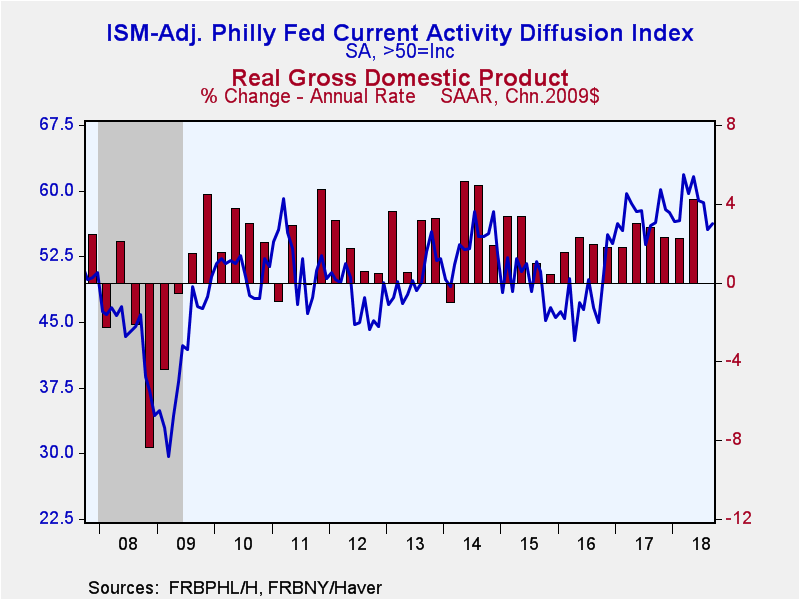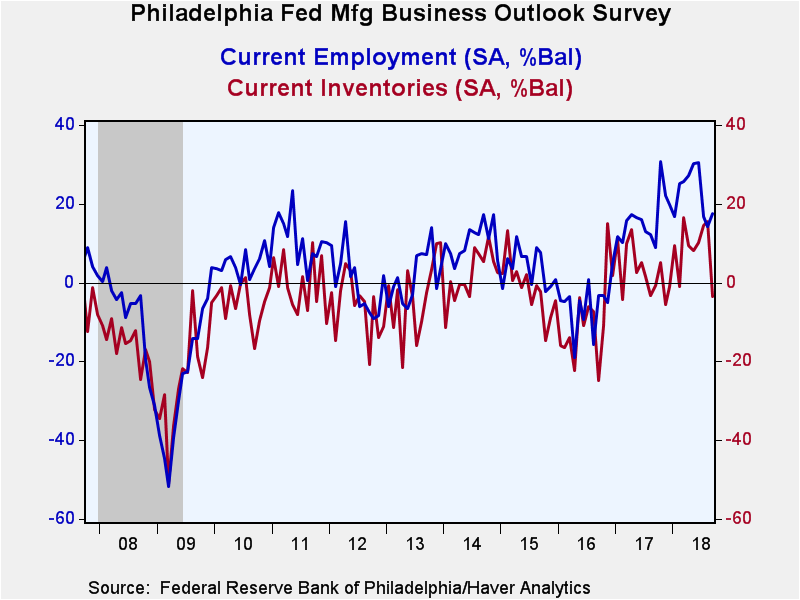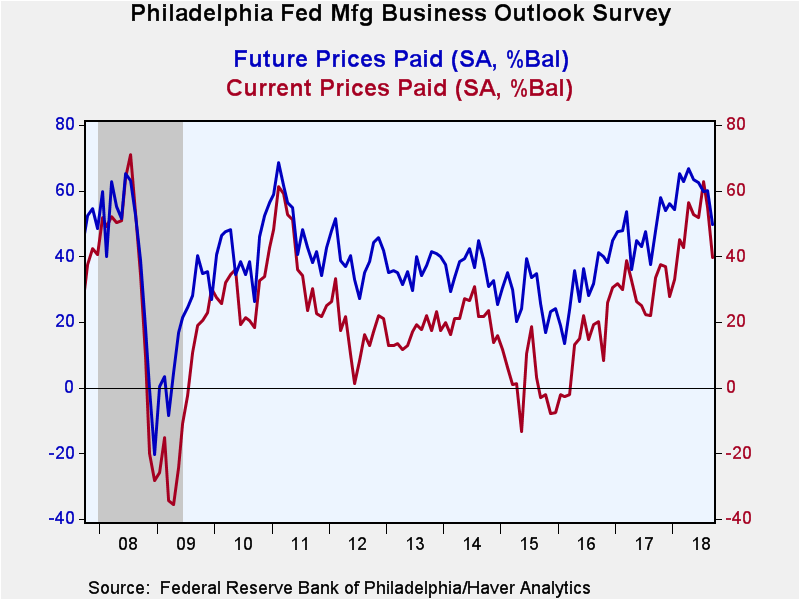 Global| Sep 20 2018
Global| Sep 20 2018Philadelphia Fed Factory Conditions Improve; Prices Weaken Again
by:Tom Moeller
|in:Economy in Brief
Summary
The Philadelphia Federal Reserve reported that its General Factory Sector Business Conditions Index rose to 22.9 during September following an August decline to 11.9. The rise compared to expectations for a lesser increase to 15.0 in [...]
The Philadelphia Federal Reserve reported that its General Factory Sector Business Conditions Index rose to 22.9 during September following an August decline to 11.9. The rise compared to expectations for a lesser increase to 15.0 in the Action Economics Forecast Survey. The figures are diffusion indexes where readings above zero indicate expansion. The percentage of firms reporting an improvement in business activity rose to 38.2%. The number reporting a worsening eased to 15.3%.
Haver Analytics constructs an ISM-Adjusted General Business Conditions Index. The figure improved slightly this month to 56.3 following a sharp August decline to 55.6. During the last ten years, there has been a 66% correlation between the quarterly ISM-adjusted Philadelphia Fed Index and quarterly real GDP growth.
Modest improvement in the component readings was widespread throughout the survey. The new orders reading recovered roughly half of its August decline and continued to suggest moderate growth. The shipments reading edged higher after a sharp decline. Unfilled orders posted a firm increase and a rise in the delivery time index suggested a modest slowing of product delivery speeds. Working the other way, the inventories index fell sharply and indicated decumulation for the first time since February.
The labor market indicators improved this month. The employment index rose slightly, but remained down sharply versus the Q2 high. During the last ten years, there has been an 81% correlation between the index level and the month-to-month change in manufacturing employment. The share of firms reporting a rising level of payrolls recovered modestly following sharp declines in the prior two months. A higher nine percent reported a decrease in payrolls. The average workweek series recovered a piece of the declines during the prior two months, but remained down sharply from the expansion high reached in May.
The prices paid index declined sharply to the lowest level since January. The percent of respondents reporting higher prices paid collapsed to 44.4, while a lessened five percent paid less. The index of prices received backed off to a nine-month low.
The future activity index slipped m/m and remained well below its March 2017 high. Most of the component series fell including new orders, shipments, employment and capital expenditures. The prices paid series deteriorated to a twelve-month low, and expected prices received fell from its thirty-year high.
The survey panel consists of 150 manufacturing companies in the third Federal Reserve District (which consists of southeastern PA, southern NJ and Delaware). The diffusion indexes represent the percentage of respondents indicating an increase minus the percentage indicating a decrease in activity. The ISM-adjusted figure, calculated by Haver Analytics, is the average of five diffusion indexes: new orders, shipments, employment, delivery times and inventories with equal weights (20% each). Each ISM-adjusted index is the sum of the percent responding "higher" and one-half of the percent responding "same."
The figures from the Philadelphia Federal Reserve dating back to 1968 can be found in Haver's SURVEYS database. The expectation from the Action Economics Forecast Survey is available in AS1REPNA.
| Philadelphia Fed - Manufacturing Business Outlook Survey (%, SA) | Sep | Aug | Jul | Sep'17 | 2017 | 2016 | 2015 |
|---|---|---|---|---|---|---|---|
| General Factory Sector Business Conditions | 22.9 | 11.9 | 25.7 | 25.8 | 27.4 | 4.9 | 3.7 |
| ISM-Adjusted Business Conditions | 56.3 | 55.6 | 58.6 | 56.4 | 57.2 | 48.3 | 49.4 |
| New Orders | 21.4 | 9.9 | 31.4 | 28.9 | 25.4 | 4.9 | 3.0 |
| Shipments | 19.6 | 16.6 | 24.7 | 27.3 | 26.8 | 6.9 | 3.0 |
| Unfilled Orders | 12.6 | 5.6 | 11.0 | 15.2 | 11.9 | -5.6 | -5.1 |
| Delivery Time | 11.1 | 6.4 | 11.0 | 13.2 | 10.6 | -4.6 | -4.2 |
| Inventories | -3.5 | 15.4 | 14.4 | -0.8 | 2.8 | -9.6 | -1.4 |
| Number of Employees | 17.6 | 14.3 | 16.8 | 8.9 | 16.2 | -5.6 | 3.9 |
| Average Workweek | 14.6 | 10.7 | 13.7 | 13.5 | 14.9 | -5.4 | -1.7 |
| Prices Paid | 39.6 | 55.0 | 62.9 | 33.5 | 30.4 | 13.5 | 1.5 |
| Expectations - General Business Conditions; Six Months Ahead | 36.3 | 38.8 | 29.0 | 55.0 | 47.1 | 33.7 | 37.6 |
Tom Moeller
AuthorMore in Author Profile »Prior to joining Haver Analytics in 2000, Mr. Moeller worked as the Economist at Chancellor Capital Management from 1985 to 1999. There, he developed comprehensive economic forecasts and interpreted economic data for equity and fixed income portfolio managers. Also at Chancellor, Mr. Moeller worked as an equity analyst and was responsible for researching and rating companies in the economically sensitive automobile and housing industries for investment in Chancellor’s equity portfolio. Prior to joining Chancellor, Mr. Moeller was an Economist at Citibank from 1979 to 1984. He also analyzed pricing behavior in the metals industry for the Council on Wage and Price Stability in Washington, D.C. In 1999, Mr. Moeller received the award for most accurate forecast from the Forecasters' Club of New York. From 1990 to 1992 he was President of the New York Association for Business Economists. Mr. Moeller earned an M.B.A. in Finance from Fordham University, where he graduated in 1987. He holds a Bachelor of Arts in Economics from George Washington University.










